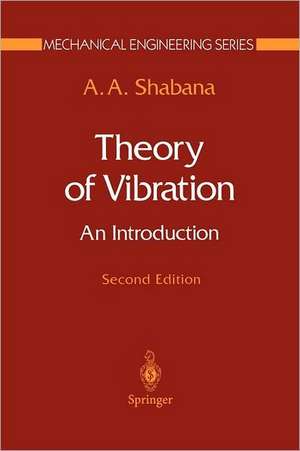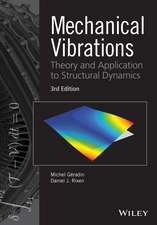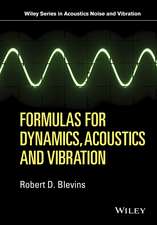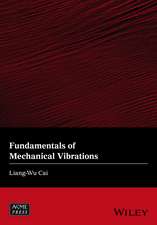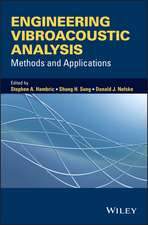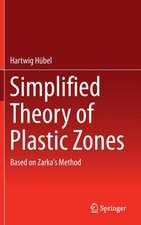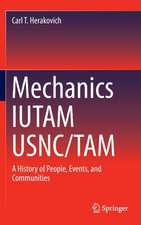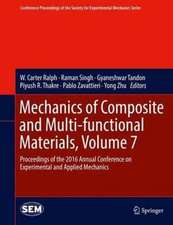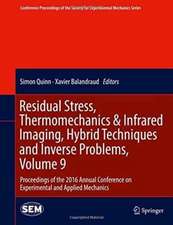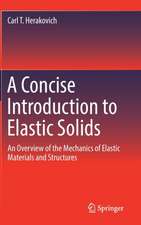Theory of Vibration: An Introduction: Mechanical Engineering Series
Autor A.A. Shabanaen Limba Engleză Paperback – 16 sep 2011
| Toate formatele și edițiile | Preț | Express |
|---|---|---|
| Paperback (2) | 391.40 lei 6-8 săpt. | |
| Springer – 8 mar 2012 | 391.40 lei 6-8 săpt. | |
| Springer – 16 sep 2011 | 559.43 lei 38-45 zile | |
| Hardback (1) | 736.16 lei 6-8 săpt. | |
| Springer – 8 dec 1995 | 736.16 lei 6-8 săpt. |
Din seria Mechanical Engineering Series
-
 Preț: 391.84 lei
Preț: 391.84 lei - 18%
 Preț: 1110.72 lei
Preț: 1110.72 lei - 15%
 Preț: 593.73 lei
Preț: 593.73 lei - 18%
 Preț: 944.99 lei
Preț: 944.99 lei - 15%
 Preț: 653.14 lei
Preț: 653.14 lei - 17%
 Preț: 363.12 lei
Preț: 363.12 lei - 18%
 Preț: 1239.05 lei
Preț: 1239.05 lei - 15%
 Preț: 640.06 lei
Preț: 640.06 lei - 18%
 Preț: 1129.65 lei
Preț: 1129.65 lei - 15%
 Preț: 522.24 lei
Preț: 522.24 lei - 15%
 Preț: 654.77 lei
Preț: 654.77 lei - 15%
 Preț: 643.34 lei
Preț: 643.34 lei - 15%
 Preț: 611.40 lei
Preț: 611.40 lei - 18%
 Preț: 765.96 lei
Preț: 765.96 lei - 20%
 Preț: 631.70 lei
Preț: 631.70 lei - 18%
 Preț: 1009.22 lei
Preț: 1009.22 lei -
 Preț: 418.34 lei
Preț: 418.34 lei - 15%
 Preț: 640.71 lei
Preț: 640.71 lei -
 Preț: 403.53 lei
Preț: 403.53 lei - 18%
 Preț: 813.97 lei
Preț: 813.97 lei - 18%
 Preț: 1386.48 lei
Preț: 1386.48 lei - 18%
 Preț: 951.47 lei
Preț: 951.47 lei - 18%
 Preț: 833.09 lei
Preț: 833.09 lei - 18%
 Preț: 936.60 lei
Preț: 936.60 lei - 15%
 Preț: 644.49 lei
Preț: 644.49 lei - 18%
 Preț: 941.05 lei
Preț: 941.05 lei - 18%
 Preț: 1386.17 lei
Preț: 1386.17 lei -
 Preț: 399.67 lei
Preț: 399.67 lei - 18%
 Preț: 1389.44 lei
Preț: 1389.44 lei - 18%
 Preț: 790.46 lei
Preț: 790.46 lei - 18%
 Preț: 1388.22 lei
Preț: 1388.22 lei - 18%
 Preț: 1024.53 lei
Preț: 1024.53 lei - 15%
 Preț: 590.16 lei
Preț: 590.16 lei - 18%
 Preț: 1234.00 lei
Preț: 1234.00 lei - 18%
 Preț: 1386.62 lei
Preț: 1386.62 lei - 15%
 Preț: 543.85 lei
Preț: 543.85 lei -
 Preț: 391.61 lei
Preț: 391.61 lei - 18%
 Preț: 944.19 lei
Preț: 944.19 lei - 18%
 Preț: 736.16 lei
Preț: 736.16 lei - 18%
 Preț: 943.88 lei
Preț: 943.88 lei - 15%
 Preț: 693.21 lei
Preț: 693.21 lei - 18%
 Preț: 781.77 lei
Preț: 781.77 lei - 15%
 Preț: 639.08 lei
Preț: 639.08 lei - 23%
 Preț: 737.28 lei
Preț: 737.28 lei - 15%
 Preț: 641.53 lei
Preț: 641.53 lei -
 Preț: 401.42 lei
Preț: 401.42 lei
Preț: 559.43 lei
Preț vechi: 690.65 lei
-19% Nou
Puncte Express: 839
Preț estimativ în valută:
107.04€ • 111.76$ • 88.59£
107.04€ • 111.76$ • 88.59£
Carte tipărită la comandă
Livrare economică 31 martie-07 aprilie
Preluare comenzi: 021 569.72.76
Specificații
ISBN-13: 9781461284567
ISBN-10: 1461284562
Pagini: 368
Dimensiuni: 155 x 235 x 19 mm
Greutate: 0.51 kg
Ediția:2nd ed. 1996. Softcover reprint of the original 2nd ed. 1996
Editura: Springer
Colecția Springer
Seria Mechanical Engineering Series
Locul publicării:New York, NY, United States
ISBN-10: 1461284562
Pagini: 368
Dimensiuni: 155 x 235 x 19 mm
Greutate: 0.51 kg
Ediția:2nd ed. 1996. Softcover reprint of the original 2nd ed. 1996
Editura: Springer
Colecția Springer
Seria Mechanical Engineering Series
Locul publicării:New York, NY, United States
Public țintă
GraduateTextul de pe ultima copertă
This
fully
revised
and
updated
third
edition
covers
the
physical
and
mathematical
fundamentals
of
vibration
analysis,
including
single
degree
of
freedom,
multi-degree
of
freedom,
and
continuous
systems.
A
new
chapter
on
special
topics
that
include
motion
control,
impact
dynamics,
and
nonlinear
dynamics
is
added
to
the
new
edition.
In
a
simple
and
systematic
manner,
the
book
presents
techniques
that
can
easily
be
applied
to
the
analysis
of
vibration
of
mechanical
and
structural
systems.
Suitable
for
a
one-semester
course
on
vibrations,
the
book
presents
the
new
concepts
in
simple
terms
and
explains
procedures
for
solving
problems
in
considerable
detail.
It
contains
numerous
exercises,
examples
and
end-of-chapter
problems.
· Features updates and revisions to all chapters including coverage of important nonlinear dynamics topics;
· Provides lucid yet rigorous review of the mathematics needed for the solution of the vibration equations;
· Presents complete coverage of the theory of vibration with focus on the fundamentals, numerical and computer methods;
· Reinforces concepts with numerous exercises and examples and end-of-chapter problems;
Includes a Fortran code for solving ODEs of nonlinear systems.vibration
· Features updates and revisions to all chapters including coverage of important nonlinear dynamics topics;
· Provides lucid yet rigorous review of the mathematics needed for the solution of the vibration equations;
· Presents complete coverage of the theory of vibration with focus on the fundamentals, numerical and computer methods;
· Reinforces concepts with numerous exercises and examples and end-of-chapter problems;
Includes a Fortran code for solving ODEs of nonlinear systems.vibration
Cuprins
1 Introduction.- 1.1 Basic Definitions.- 1.2 Elements of the Vibration Models.- 1.3 Particle Dynamics.- 1.4 Systems of Particles.- 1.5 Dynamics of Rigid Bodies.- 1.6 Linearization of the Differential Equations.- 1.7 Idealization of Mechanical and Structural Systems.- Problems.- 2 Solution of the Vibration Equations.- 2.1 Homogeneous Differential Equations.- 2.2 Initial Conditions.- 2.3 Solution of Nonhomogeneous Equations with Constant Coefficients.- 2.4 Stability of Motion.- Problems.- 3 Free Vibration of Single Degree of Freedom Systems.- 3.1 Free Undamped Vibration.- 3.2 Analysis of the Oscillatory Motion.- 3.3 Stability of Undamped Linear Systems.- 3.4 Continuous Systems.- 3.5 Equivalent Systems.- 3.6 Free Damped Vibration.- 3.7 Logarithmic Decrement.- 3.8 Structural Damping.- 3.9 Coulomb Damping.- 3.10 Self-Excited Vibration.- 3.11 Motion Control.- 3.12 Impact Dynamics.- Problems.- 4 Forced Vibration.- 4.1 Differential Equation of Motion.- 4.2 Forced Undamped Vibration.- 4.3 Resonance and Beating.- 4.4 Forced Vibration of Damped Systems.- 4.5 Rotating Unbalance.- 4.6 Base Motion.- 4.7 Measuring Instruments.- 4.8 Experimental Methods for Damping Evaluation.- Problems.- 5 Response to Nonharmonic Forces.- 5.1 Periodic Forcing Functions.- 5.2 Determination of the Fourier Coefficients.- 5.3 Special Cases.- 5.4 Vibration Under Periodic Forcing Functions.- 5.5 Impulsive Motion.- 5.6 Response to an Arbitrary Forcing Function.- 5.7 Frequency Contents in Arbitrary Forcing Functions.- 5.8 Computer Methods in Nonlinear Vibration.- Problems.- 6 Systems with More Than One Degree of Freedom.- 6.1 Free Undamped Vibration.- 6.2 Matrix Equations.- 6.3 Damped Free Vibration.- 6.4 Undamped Forced Vibration.- 6.5 Vibration Absorber of the Undamped System.- 6.6 Forced Vibration of Damped Systems.- 6.7 The Untuned Viscous Vibration Absorber.- 6.8 Multi-Degree of Freedom Systems.- Problems.- 7 Continuous Systems.- 7.1 Free Longitudinal Vibrations.- 7.2 Free Torsional Vibrations.- 7.3Free Transverse Vibrations.- 7.4 Orthogonality of the Eigenfunctions.- 7.5 Forced Longitudinal and Torsional Vibrations.- 7.6 Forced Transverse Vibrations.- Problems.- References.- Answers to Selected Problems.
Recenzii
"The text is particularly easy to read and moves from one section to the next with no major changes in style. It is obvious that the structure of the material is...based on a set of mature class notes...a very worthwhile addition to the vibration literature" - Proceedings of the Institution of Mechanical Engineers
Caracteristici
Request lecturer material: sn.pub/lecturer-material
